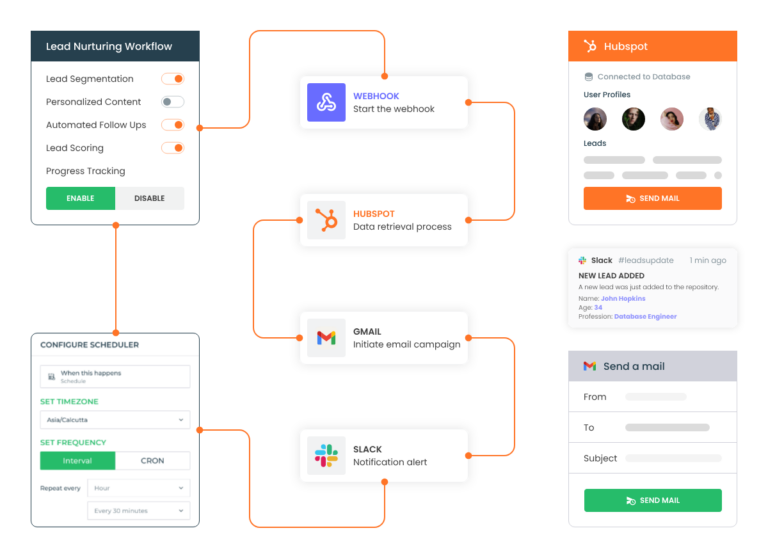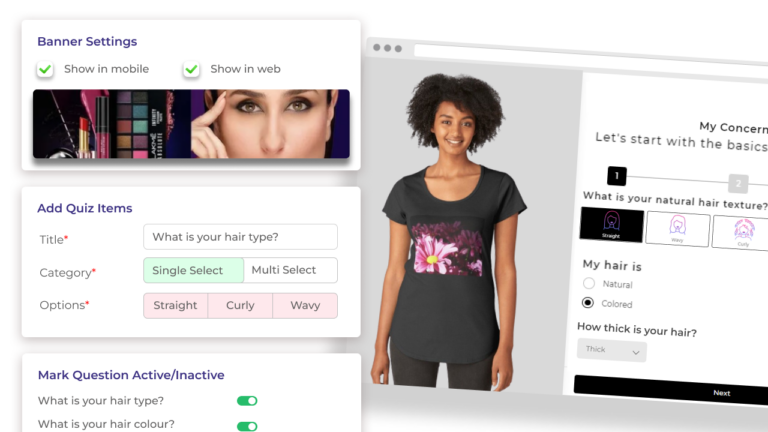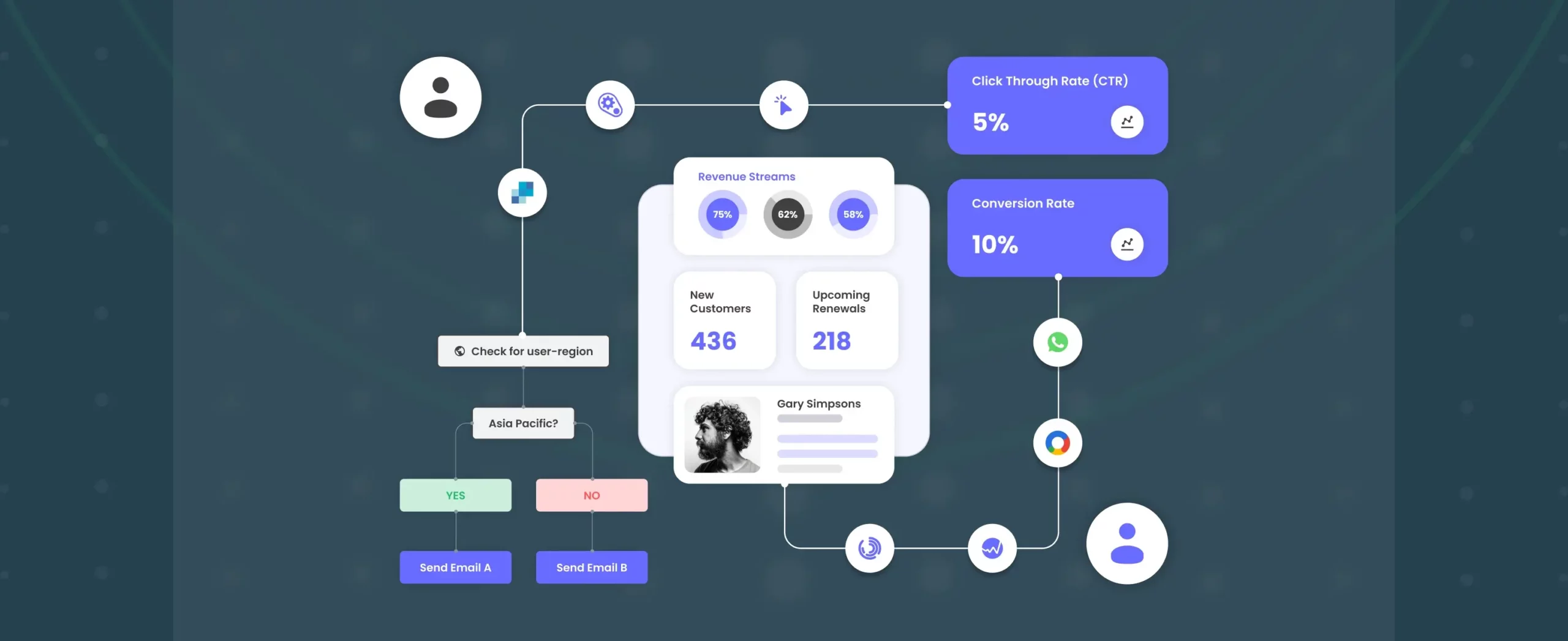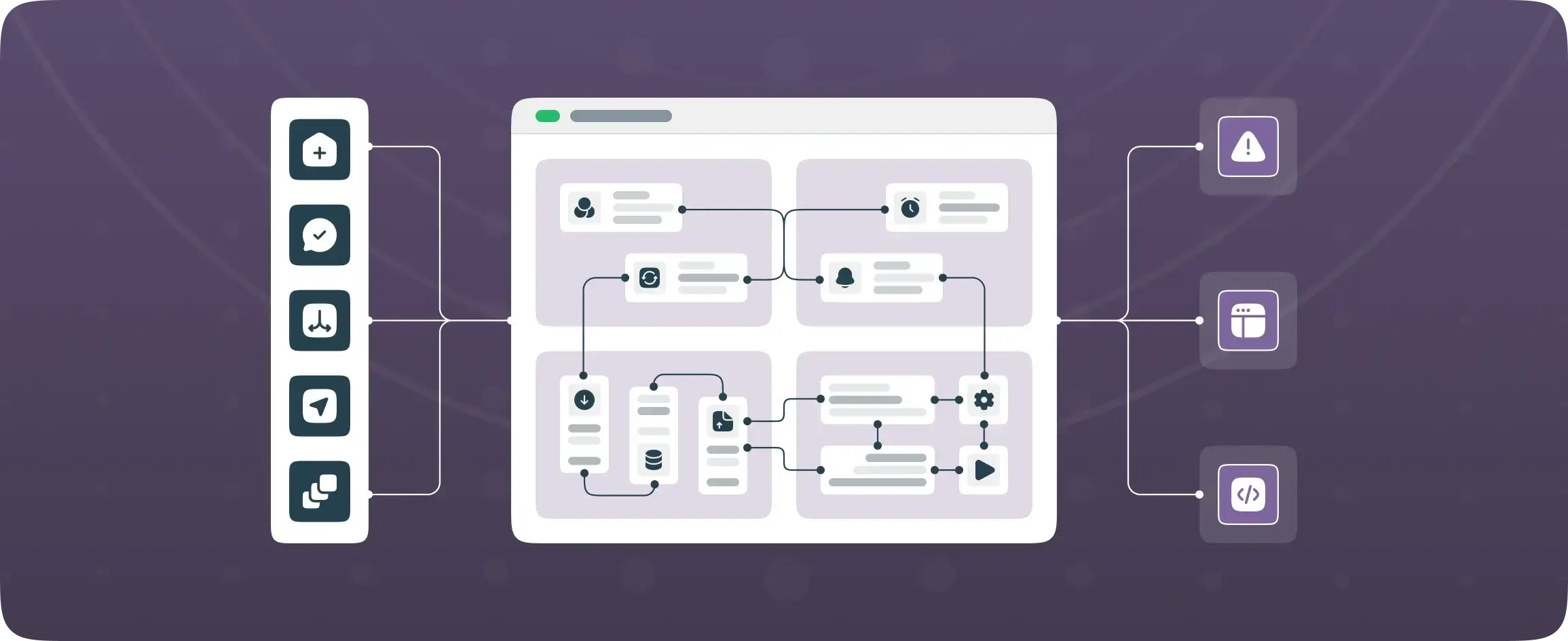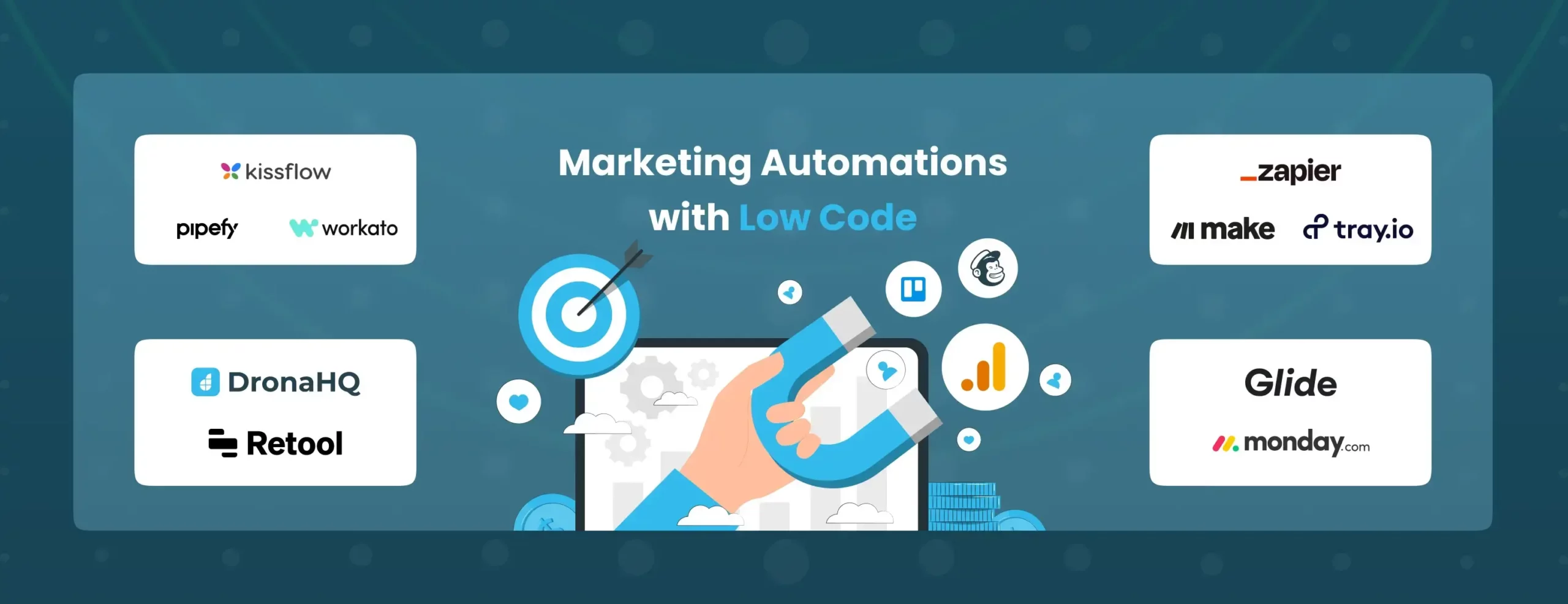

How no-code tools are reshaping marketing automation
Back in 2019, I took upon a marketing automation challenge to increase our email list generation with meaningful lead magnets – ebooks, case studies, webinars, whitepapers – the works. I wanted to set up the landing pages, embed data capture web forms while using only a single form that changes dynamically based on the page it’s embedded in, and then enter a workflow that performs the standard tasks – send an email to the recipient, an alert to internal teams, add or update lead in the database and reflect lead activity in the CRM.
Sounds like a laundry list of to-dos, no? But I didn’t spend any time combing through UI libraries, learning website design practices, or configuring complicated APIs for the database, CRM, or email tools. Instead, I logged into a no-code builder, created a form, defined form rules to dynamically hide-show form fields across the different pages, captured UTM parameters to auto-populate form fields, and then set a workflow to define tasks upon button click.
Within less than a week’s effort, I was able to generate a comprehensive lead capture form that’s purpose-built to fit into our team’s strategies.
We’re now in 2024 and the embedded forms are still going strong. Easy to update, maintain, and explain to new marketing team members, seamlessly integrated with our CRM, internal communications, and databases.
This is just one example of the kind of superpowers marketers can have in their hands with no-code solutions.
In this blog, we look at how no-code is reshaping marketing automations, where you can get started, how the story extends beyond the Marketos and the Zapiers of the world, how to get the teams’ buy-ins, and where you can get started.
Make marketing teams self-sufficient, automations holistic
Are you familiar with the game of Chinese whispers? I’m sure you are. It’s a classic illustration of how miscommunication can lead to distortion as a message passes from one person to another. Similarly, when marketing requirements are relayed to IT teams, there’s often a risk of misinterpretation, leading to delays and inefficiencies. However, by embracing no-code solutions, marketing teams gain a remarkable advantage. No longer reliant on intricate coding or IT support, they become self-sufficient architects of their campaigns, swiftly bringing their visions to life with agility and precision. This empowerment enhances productivity and fosters a culture of innovation, where marketing professionals can readily experiment and iterate without barriers.
It’s rare to get the kind of technical support you need exactly when needed. And you don’t want to be in a position where you’re solely dependent on an IT department or external developers to get your projects, campaigns or plans moving.
No-code isn’t just about convenience – it’s about empowerment. It’s about giving marketers the tools they need to innovate and iterate quickly, without being limited by technical constraints. With no-code, marketers can experiment with new ideas, iterate on existing processes, and adapt to changing market dynamics with ease.
Eliminate or limit the effects of bottlenecks that slow down business processes. Just think about the cost related to activities such as data capture, the sharing of information within teams, the need to keep track of budget or to record the progress of a project. No-code platforms have responded to these needs with solutions.
No-code and marketing teams: A match made in heaven
Marketing has always been like a high-speed race where trends sprint, best practices jog, and strategies change gears faster than Usain Bolt on a caffeine rush. (I’m rather proud of this analogy, what do you say?)
And being a marketer means wearing more hats than a hat store in a hurricane store. From project management and strategy to operations and data analysis, you’re juggling so many tasks that your focus ends up resembling a scatter plot rather than a laser beam.
So what is a marketer to do?
A beacon of hope rises amidst the chaos: no-code automations. It’s not just about the basic automation features built into your existing marketing tools; we’re talking about automating entire processes, from tracking your very first lead to assembling that final report on campaign performance.
Automations and why we love them
Looking to put things on autopilot? That weekly report is emailed to managers every Monday on autopilot. Every event registration receives email alerts pre and post-events, on autopilot. Teammates go on a leave and high-priority tasks are distributed, on autopilot. Autopilot!
You like the sound of it, right?
Automations – or running tasks on autopilot – are kind of like having an intern who never sleeps and never drops the ball. Predefined emails were sent out at key milestones on the customer’s user journey, and seasonal reports auto generated and emailed to key stakeholders. Automations can take the form of a time-based triggered, user-initiated, or API or Webhook-triggered (think change happening in salesforce leading to an auto alert on your marketing teams slack channel) series of events.
And how does no-code fit into the picture?
“No-code tools are pretty much made for those working in marketing teams – people looking to do more with less and get things moving quickly.” – Anonymous
The way Canva disrupted creative designing, WordPress disrupted website development, Stripe disrupted digital payments, and Shopify disrupted e-commerce building – no-code tools are disrupting software development.
It was not that long ago that when you needed a simple website lead capture form embedded into your website, you would need to go seek assistance from the website developer IT teams, hire a martech professional, or open up YouTube to learn and do it yourself (Yes we are marketers, yes we are frugal, yes we like DIYing projects before adding on dependencies 😉).
Now, take my experience with lead generation as an example. In the past, setting up a comprehensive lead capture form required navigating through various UI libraries, understanding complex APIs, and coordinating with different teams for deploying that code. It was a time-consuming process that often required technical expertise beyond my skill set.
But with no-code tools, the process became effortless. I could focus on crafting compelling content and strategizing, while the tool took care of the technical aspects. From designing the form to setting up automated workflows, everything was intuitive and accessible.
I cannot put it any better than Scott Brinker, often regarded as the godfather of martech, has to say about no-code and marketers:
Marketing ops, sales ops, rev ops — these disciplines thrive on logic and programmatic thinking. Customer journey maps, orchestrated by marketing automation tools, are handed off to algorithmic sales sequences driven by conditional triggers and actions… these are savvy software “programs” that are crafted by experts in their domain. No-code tools empower people with deep domain expertise — and perfectly fine logic and programmatic thinking skills, whose only “flaw” is that they didn’t learn to code Python — to quickly and efficiently turn their knowledge into better digital operations and experiences.
Categories of no-code solutions:
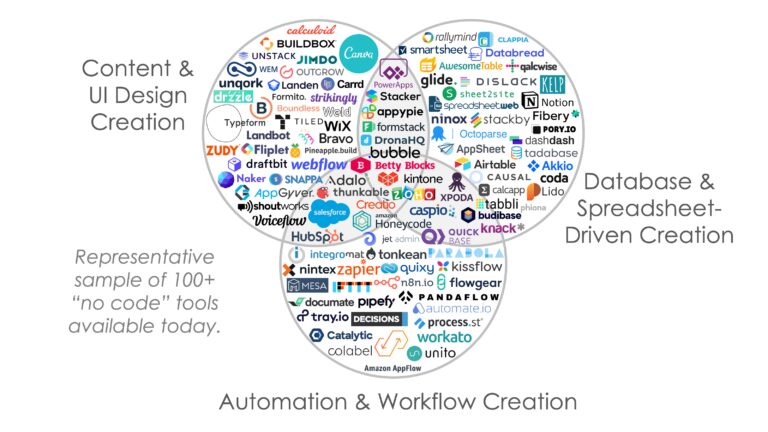
Apps, websites, dashboards, project management tools, chatbots, integration and automation, forms – you’re sure to find a no-code solution to fit the bill.
Types of no-code tools that enable Marketing Automation
- BPM Workflow Tools – Kissflow, Pipefy, Workato
In the no-code automation tools category – processes are defined by triggers and actions and well-defined stages. Tools like Kissflow, and Workato are pretty popular for their workflow capabilities. These platforms are industry-agnostic, driving business process workflows for simple to complex processes. - Integration Platforms – Zapier, Make, Tray
Integration as a no-code capability has its category of products, such as Zapier, Tray, Make (previously Integromat), etc. Zapier, in particular, has done an impressive job at providing ready-to-use zaps for non-coders to get their hands dirty with marketing integrations. - All-in-one Platforms (App builders) – DronaHQ, Retool, Glide, Monday
You also get platforms that provide a host of more capabilities such as creative designing, UI capabilities, integration using APIs, user access management, distribution management, and of course, automation capabilities to run trigger-based workflows. Platforms include DronaHQ, Bubble, Glide, HubSpot, (each offering its own set of specialities), and more.
In a recent success story at DronaHQ, a heavy machinery manufacturing company SANY, used the platform’s drag-and-drop capabilities to create a CRM-integrated application to capture lead details at one-off events. Accessible anytime, anywhere through a mobile or a web app, or as a shareable link. No tickets with IT needed to be filed. All self-serve, drag-and-drop, intuitive if-then logic.
The fun with automation begins when you start to integrate and automate tasks across different tools and databases.
Advantages of no-code Automation Solutions
Let’s break down some of the more fun (and advantageous) capabilities of a no-code platform that powers more comprehensive automation recipes that go beyond simple point A to point B tasks.
- Integration: No-code platforms excel in integrating multiple web apps into a centralized, user-friendly platform. This integration simplifies workflows and mitigates tool sprawl, streamlining processes and enhancing efficiency. Integration is a core competency for no-code platforms.
- Ready Logic Blocks: With pre-built logic blocks like “IF – this – then – that,” no-code platforms offer intuitive tools for constructing automation workflows. (Note: Yes, there’s even a platform with that exact name, ideal for crafting straightforward workflows.)
- Customization: No-code platforms provide extensive customization options, allowing users to tailor automation workflows to their precise specifications. This flexibility ensures that automation solutions align perfectly with unique business requirements.
- Scalability: One of the standout advantages of no-code solutions is their scalability. These platforms seamlessly adapt to evolving business needs without requiring extensive development resources.
Note: It’s essential to consider scalability and cost implications when evaluating no-code platforms. For instance, some platforms may experience skyrocketing license costs as new users or processes are added, potentially becoming a barrier for teams and necessitating a transition to new systems altogether. When evaluating platforms, it is also important to look at the pricing structures as you may find all kinds of pricing options across the marketplace.
No-code Marketing Automation Examples
As soon as you type no-code marketing automation into Google, you will get the standard (very important) examples – lead capture forms and email automation, integration with CRM, automatic social media posts, cross-departmental communication, data analytics, and reporting. Let’s see some examples that are a bit more comprehensive, inspiring, and necessary:
- Personalized website experiences: Marketers can create dynamic website experiences that personalize content based on visitor behaviour, such as previous interactions or demographics. This level of customization goes beyond simple data transfer between applications and allows for more tailored user experiences.
Beauty internet company Purplle brings more customization and speed to drive engaging on-website experiences for visitors using a custom app to run targeted ads and quizzes. One single app to drive rich website visitor experiences. ‘We used DronaHQ to streamline website visitor interactions and personalize product recommendations shared with customers’ -Suyash Katyayani, Co-Founder & CTO, Purplle - Predictive lead scoring: Leveraging machine learning algorithms available in certain no-code platforms, marketers can build predictive lead scoring models to identify high-value prospects. By analyzing historical data and user attributes, the system can automatically assign scores to leads, enabling sales teams to prioritize their efforts effectively.
- Customer Relationship Management (CRM): Integrating CRM systems with marketing automation workflows, automating lead scoring, follow-ups, and data synchronization to enhance customer relationship management efforts.
- Automated A/B Testing: With a no-code automation tool, marketers can set up and execute A/B tests across various channels, such as email campaigns or in-app experiences. The platform can automatically divide the audience, track performance metrics, and determine the winning variant based on predefined success criteria.
- Embeddable AI chatbots: Using NLP APIs that can be integrated in some no-code platforms, marketers can create intelligent chatbots that engage with website visitors or social media users in real time. These chatbots can answer common questions, provide product recommendations, and even initiate lead-capture processes autonomously.
- Cross-team communication workflows: No-code platforms with advanced analytics capabilities can enable marketers to build sophisticated automation for scenarios such as reporting and analytics. Consolidating data from disparate sources and creating a unified view for all stakeholders to collaborate effectively.
Heavy machinery manufacturer SANY redefines internal newsletter management – all company news, product updates, and latest releases go from marketing and sales teams to the SANY device owners instantly on their no-coded SANY apps. - Automated content generation: Marketers can leverage AI capabilities and their existing content to automate the creation of posts, social media updates, or email newsletters. These tools can generate content based on predefined topics, keywords, or audience preferences, saving time and effort while ensuring a consistent publishing schedule.
How to begin your no-code marketing automation journey?
- Rise to the challenge. I’d like to reiterate what Philip Kotler did, marketing is a race without a finish line. It is all and always about the right mix of strategy and implementation. Challenge your team to commit to change and embrace a transformative way of work (by experimenting and adapting new technologies).
- Identify that there are gaps and that there are solutions. The first step is to uncover gaps. Any holes in your current processes? If yours is a young business just starting, this step might just mean that you outline the ideal workflow. Ask questions like – Do all efforts carry clear ROI? Are all our SaaS subscriptions and add-on licenses justified? Are we making the most of it? Is the product documentation up to date? Are all leads captured receiving nurture emails as per the right segmentation? Are we tracking the analytics? Is the sales team able to find the collaterals marketing teams produce?
- How do the gaps relate to the broader causes? After you have identified some of the ‘symptoms’, it’s time to connect the dots to find out the broader issues. Are there too many data sources that do not unify and speak with each other? Are you using more than one tool to solve the same problem? Are your cross-team collaborations in need of therapy?
A recent survey of more than 300 marketing leaders found that it’s just as difficult to collaborate with people outside the team, as it is to collaborate with folks external to the company.
- Start consolidating data sources. Moving quickly together is more achievable when you connect teams at the data layer—ensuring that critical information is shared in real time between departments. Enable rapid collaboration by centralizing data sharing across teams, ensuring real-time access to critical information. Start by identifying disparate data sources in Marketing, establish a shared taxonomy, and consolidate or connect duplicate sources. Customize views for stakeholders and integrate the central source with other teams for unified operations.
Finding the best No-Code Tool for Marketing Automation
With the growing popularity of no-code tools in marketing automation, selecting the right platform for your specific needs can be a daunting task. However, by considering the following factors, you can narrow down your options and find the perfect fit for your marketing operations:
- Feature Set: Start by identifying the core features you require for your marketing automation workflows. Look for platforms that offer a comprehensive suite of tools, including form builders, workflow automation, integration capabilities, and analytics.
- Ease of Use: No-code tools are prized for their user-friendly interfaces and intuitive design. Choose a platform that enables non-technical users to create and manage automation workflows effortlessly. Consider conducting a trial or demo to assess the usability of the platform.
- Integration Capabilities: Seamless integration with your existing tech stack is crucial for maximizing the efficiency of your marketing operations. Ensure that the no-code tool you select supports integration with popular CRM systems, email marketing platforms, analytics tools, and other essential software.
- Scalability: As your marketing needs evolve and your business grows, your automation platform should be able to scale accordingly. Look for a solution that offers scalability without compromising performance or ease of use.
- Customization Options: Every marketing team has unique requirements and workflows. Choose a no-code tool that provides ample customization options, allowing you to tailor automation workflows to your specific needs.
- Support and Training: Evaluate the level of support and training offered by the no-code platform provider. Look for resources such as documentation, tutorials, and customer support channels to assist you in getting started and troubleshooting issues along the way.
- Cost and Pricing Structure: Finally, consider the cost and pricing structure of the no-code tool. Look for transparent pricing plans that align with your budget and offer flexibility as your usage scales. Be mindful of hidden costs such as additional fees for integrations or advanced features.
By carefully considering these factors and conducting thorough research, you can find the ideal no-code tool for your marketing automations, empowering your team to drive efficiency, innovation, and success in your marketing initiatives.
PS: It doesn’t have to be one size fits all. Studies suggest that organizations use anywhere from 3 to 7 no-code platforms to drive various operational initiatives at any given time.
Conclusion:
The concept of “citizen developers” in marketing, empowered by no-code tools, is reshaping the way marketers approach automation. Marketers must embrace the potential of these tools in streamlining processes, enhancing efficiency, and unlocking new opportunities for innovation. By leveraging these tools alongside traditional methods, marketers can maximize their impact and stay ahead in an increasingly dynamic digital environment.
DronaHQ ticks all the boxes when it comes to choosing the right no-code platform for marketing automation. Its user-friendly interface, comprehensive functionality, seamless integration, scalability, and cost-effectiveness make it the top choice for businesses looking to streamline their marketing efforts and drive success.

